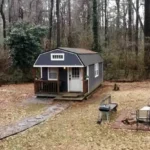Off-grid living refers to living without being connected to the public utility grid for electricity, water, or sewage. It can be a great way to reduce your environmental impact and become more self-sufficient. Here are some tips to get started with off-grid living:

- Start with a plan: Before you start living off the grid, it’s important to have a plan in place. Determine what your energy needs are and how you will meet them. Think about water sources, waste disposal, and food production.
- Choose a location: Choose a location that’s suitable for off-grid living. Look for an area with plenty of sun for solar power and a nearby source of water.
- Install solar panels: Solar panels are a great way to generate your own electricity. Install enough panels to meet your energy needs.
- Collect rainwater: Rainwater can be collected and used for a variety of purposes. Install a rainwater harvesting system to collect rainwater from your roof.
- Install a composting toilet: A composting toilet can help you manage waste without relying on a sewer system. It uses natural processes to break down waste and turn it into compost.
- Grow your own food: Growing your own food is an important part of off-grid living. Start with a small garden and gradually expand it as you gain experience.
- Learn basic survival skills: Living off the grid requires self-sufficiency. Learn basic survival skills like starting a fire, building a shelter, and finding food.
- Join an off-grid community: Joining an off-grid community can be a great way to learn from others and share resources. Look for communities in your area or online.
Remember, off-grid living requires commitment and hard work. But the rewards are worth it. By reducing your environmental impact and becoming more self-sufficient, you’ll be able to live a simpler, more fulfilling life.
When researching potential locations for off-grid living, there are a few important factors to consider:
- Climate: Consider the climate of the area you’re considering. Are there extreme temperatures or weather patterns that could make off-grid living difficult? Look for areas with moderate temperatures, plenty of sun, and manageable weather patterns.
- Water: Access to water is essential for off-grid living. Look for areas with a nearby water source, such as a river or lake. Consider the quality of the water and whether it requires treatment before use.
- Land: Look for land that’s suitable for off-grid living. Consider the soil quality, vegetation, and topography. Is the land suitable for growing crops or raising livestock?
- Regulations: Check local regulations to see if off-grid living is allowed in the area you’re considering. Some areas have zoning regulations that prohibit off-grid living or require certain permits.
- Access: Consider access to the property. Is there a road or trail that leads to the property? Can you easily access supplies and resources?
- Community: Look for areas with an off-grid community. Joining a community can provide support and resources, as well as opportunities to share knowledge and skills.
- Safety: Consider the safety of the area. Is the area prone to natural disasters or crime? Look for areas with low crime rates and manageable risks.
When researching potential locations for off-grid living, it’s important to consider all of these factors and find an area that meets your needs and preferences. Take the time to research and visit potential locations before making a decision.
The story below shows how a couple did it on little more than a quarter acre block’






